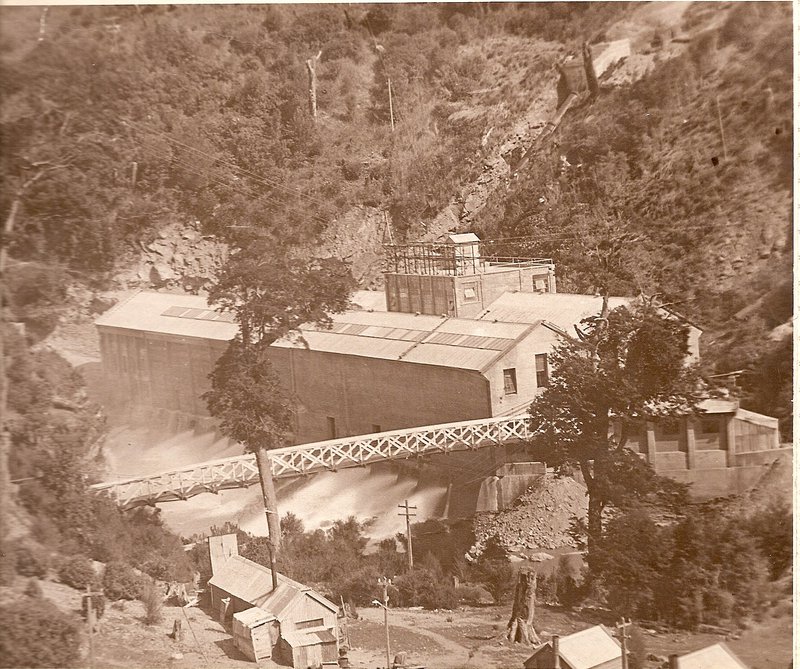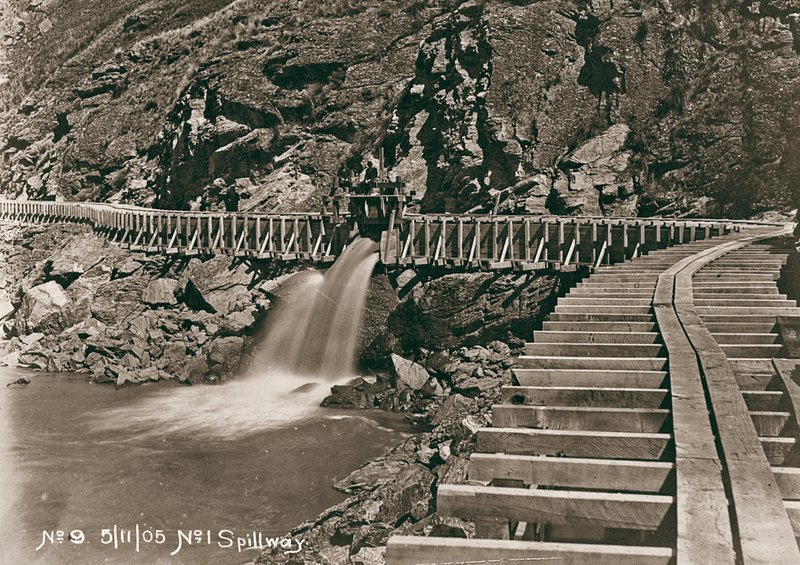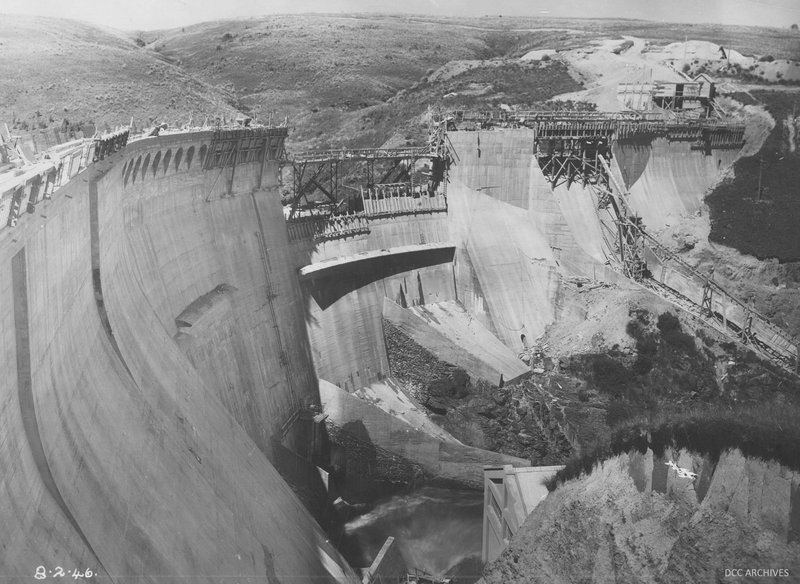Beginning operation in 1907, the Waipori power scheme has been supplying electricity to the city of Dunedin for well over 100 years. It was one of the first hydro schemes in New Zealand to provide electricity to a major urban centre.

Lake Mahinerangi and dam today, with 1A power station at bottom left. Trustpower Archive.
Dunedin in 1900 was a confident and prosperous city. Gold mining, from 1861, had brought rapid population growth and the development of infrastructure and industry. Interest in the Waipori River as the site of a possible hydro scheme was first sparked by the idea of using electricity to power gold dredges on the Waipori River flat, in the upstream reaches of the river. In 1902, a group of businessmen formed the Waipori Electric Power Company (WEPC). They aimed to supply power to the gold dredges and to residential and business customers in Dunedin and the surrounding district.
Electricity was exciting emergent technology and both private companies and local authorities had an interest in supplying this new form of power. The Dunedin City Council however, was not keen to allow the supply of electric power to fall into the hands of private business, and, with the aid of an act of parliament, bought out the scheme from WEPC and developed it as its own.
The first power station was commissioned in 1907. Initially it contained two 1,000kW alternators driven by two Pelton wheels. As Dunedin grew the scheme was expanded, with various engineering challenges overcome along the way. There are now four power stations on the Waipori River, and two on Deep Stream, producing a combined average annual output of 192GWh.

Waipori Power Station, May 1924. Trustpower Archives.
Development of the power scheme
The steep, rocky gorge that makes the Waipori River a good site for a power scheme also caused early difficulties. Frequent rockfall damaged the timber fluming which conveyed water from a weir in the river to the penstocks of the power station. As a result, the fluming was replaced by a 1.44km tunnel in 1913.

Original timber fluming in upper region of Waipori Falls Gorge. 5 November 1905. Trustpower Archives.
Demand for electricity continued to increase following World War 1 and it was soon apparent that expansion of the scheme would be required. New dams on tributaries to the Waipori River created extra storage capacity, and in 1924, an 11.6m high dam was built approximately 1.1km upstream from the original weir, flooding the Waipori River Flat to create Lake Mahinerangi. Because of poor ground conditions at this 1924 dam site, further raising of the dam was discounted and a second dam, known today as the Mahinerangi Dam, was built a short distance downstream in 1931. This was constructed in stages; first to a height of 20.4m and then raised to its present height of 34m above the river bed in 1946, submerging the upstream dam. A 2,000kW power station was constructed in 1931 at the foot of the dam.

Mahinerangi Dam construction, 1946. Dunedin City Council Archives, Electricity Series, 14/1/11/8. Photographer: AW Bathgate. https://www.flickr.com/photos/dccarchives/15241630932/in/photostream/
Two further dams and power stations were constructed downstream from the original 1907 power station in the 1950s. The original power station was completely replaced on a new site just upstream during the 1960s and 1970s.
In 1981, the Mahinerangi Dam power station was completely replaced with a new power station, intake tower in the lake, and tunnel through the right embankment of the dam. A tunnel through the Lammerlaw Range was also constructed at this time, diverting water from Deep Stream into Lake Mahinerangi.
In 2008, two additional power stations were built on the Deep Stream diversion to utilise the flow and significant head between the tunnel outlet and Lake Mahinerangi.
Full automation of the Waipori scheme was completed in 1997.
In 2011, the Waipori hydro scheme was augmented by power from the newly developed Stage 1 Mahinerangi wind farm on the north western slopes above Lake Mahinerangi, bringing the total combined average annual output of the Waipori scheme to 280GWh.
More Information
Further Reading
Henderson, M. "Brief History of the Waipori Hydro-Electric Development." New Zealand Institute of Engineers, Presidential address. Proceedings of the New Zealand Institution of Engineers, vol 28, no.1 (April, 1942): 35-67.
Martin, John E. ed. People, politics & power stations: electric power generation in New Zealand 1889-1990. Wellington: Bridget Williams Books and Electricity Corporation of New Zealand, 1991.
McKinnon, Malcolm. “Otago region - Government and politics.” Te Ara - the Encyclopedia of New Zealand. Accessed 24 January 2019. http://www.TeAra.govt.nz/en/photograph/22719/waipori-hydro-electric-scheme
Reilly, Helen. Connecting the Country: New Zealand’s National Grid 1886-2007. Wellington: Steele Roberts, 2008.
Rennie, Neil. Power to the People: 100 years of public electricity supply in New Zealand. Wellington: Electricity Supply Association of New Zealand, 1989.
Trust Power. 100 Years of Power: Waipori Hydro-electric power scheme 1907-2007. Dunedin: Trust Power Limited, 2007.
Trust Power. “Waipori Power Scheme.” Accessed January 24, 2019. https://www.trustpower.co.nz/our-assets-and-capability/power-generation/waipori
Access
Lake Mahinerangi is a popular recreation area and is accessible by road. All three power stations are visible from the road. A picnic area on a side road off Waipori Falls Road offers good views of Mahinerangi Dam.
Location
Lake Mahinerangi
